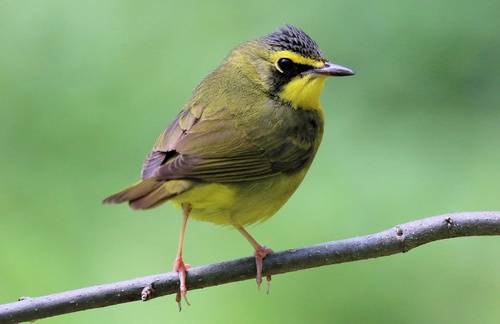
Kentucky Warbler
The Kentucky Warbler (Geothlypis formosa) is a small, vibrant songbird known for its striking yellow underparts and olive-green upperparts, complemented by a distinctive black mask and 'sideburns.' This New World warbler plays a vital role in its forest ecosystem, primarily as an insectivore, helping to control insect populations. It holds no particular widespread cultural significance, but it is a cherished sight for birdwatchers within its range due to its bright coloration and skulking behavior in the undergrowth.
12.7-14 cm
Length
20-22 cm
Wingspan
Least Concern
Conservation Status
Distribution
The Kentucky Warbler breeds in the eastern United States, primarily in the southeastern states, extending north to parts of the Midwest and Mid-Atlantic. During winter, it migrates to Central America and the Caribbean, including Mexico, Guatemala, Belize, and occasionally to northern South America.
Lifespan
Up to 8 years in the wild (based on banding records).
Kentucky Warbler's Habitat
Habitat Types
Mature deciduous forests, Bottomland hardwood forests, Forested wetlands, Areas with dense understory
Climate Zones
Temperate, Subtropical
Adaptations
Kentucky Warblers are adapted to foraging on or near the ground in dense undergrowth. Their relatively long legs and short, rounded wings facilitate maneuverability within this cluttered environment.
Variations
No recognized subspecies exist, although minor variations in plumage brightness may be observed across its range.
Appearance
Breeding Plumage
Males in breeding plumage have brighter yellow underparts and more extensive black facial markings than females or non-breeding birds. Non-breeding plumage is generally duller.
Seasonal Feather Changes
Plumage is brightest during the breeding season (spring and summer).
Sex Based Plumage Differences
Males exhibit a more pronounced black mask and 'sideburns' extending down the sides of the neck, while females have a less defined, often grayish-olive facial pattern.
Notable Features
Bold black facial mask and 'sideburns' (more prominent in males), Bright yellow throat and underparts, Olive-green upperparts
Diet and Feeding
Primary Foods
Insects, Spiders, Caterpillars, Ants, Beetles
Foraging Behavior
Primarily forages on or near the ground, gleaning insects from leaves and low vegetation. It often flips over leaves and probes the leaf litter to find prey.
Specializations
No highly specialized feeding adaptations, but its foraging behavior is well-suited to the dense understory.
Seasonal Diet Variations
Diet remains largely insectivorous year-round. The specific types of insects consumed may vary depending on availability during different seasons and in different geographic locations (breeding vs. wintering grounds).
Behavior
Social Structure
Generally solitary or found in pairs during the breeding season. May join mixed-species flocks during migration and on the wintering grounds.
Communication
A loud, ringing 'churry-churry-churry' song, Sharp 'chip' call notes, Soft 'seep' contact calls
Migration
A Neotropical migrant, traveling between breeding grounds in the eastern United States and wintering grounds in Central America and the Caribbean. Migration is primarily nocturnal.
Territorial or Group Behaviors
Males are highly territorial during the breeding season, defending their territory through song and aggressive displays against rivals. Territoriality is less pronounced on the wintering grounds.
Conservation
Threats
Habitat loss and fragmentation (both on breeding and wintering grounds), Forest degradation due to unsustainable logging practices, Collisions with buildings and other structures during migration, Pesticide use (indirectly affecting insect prey populations)
Protection Programs
Conservation of mature forests and bottomland hardwood habitats, Sustainable forestry initiatives, Efforts to reduce bird collisions with buildings
Local National Laws
Protected under the Migratory Bird Treaty Act in the United States.
Population Trend
Stable
Population Estimates
Approximately 2.4 million individuals (Partners in Flight estimate).
Interesting Facts
Kentucky Warblers are known for their skulking behavior.
They tend to stay low to the ground and move through dense undergrowth, making them sometimes difficult to observe despite their bright colors.
They are ground-nesting birds.
This makes their nests vulnerable to predators like snakes, raccoons, and domestic cats.
The name "Kentucky Warbler" is somewhat misleading.
While first described from a specimen collected in Kentucky, their breeding range extends far beyond that state.
Faqs about Kentucky Warbler
What does a Kentucky Warbler sound like?
The song is a loud, ringing 'churry-churry-churry,' often repeated several times. They also have sharp 'chip' calls.
Where can I see a Kentucky Warbler?
Look for them in mature deciduous forests with dense undergrowth during the breeding season in the eastern United States. They are more challenging to find on their wintering grounds in Central America and the Caribbean.
Are Kentucky Warblers endangered?
No, they are currently listed as a species of Least Concern by the IUCN, although habitat loss remains a potential threat.
Copyright @ Nature Style Limited. All Rights Reserved.
 English
English